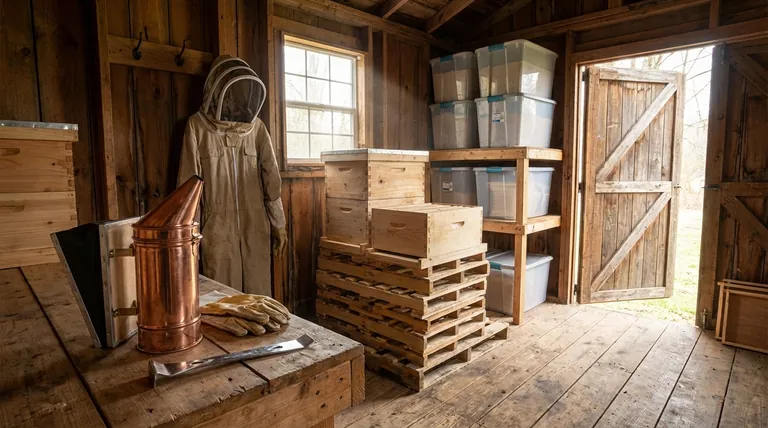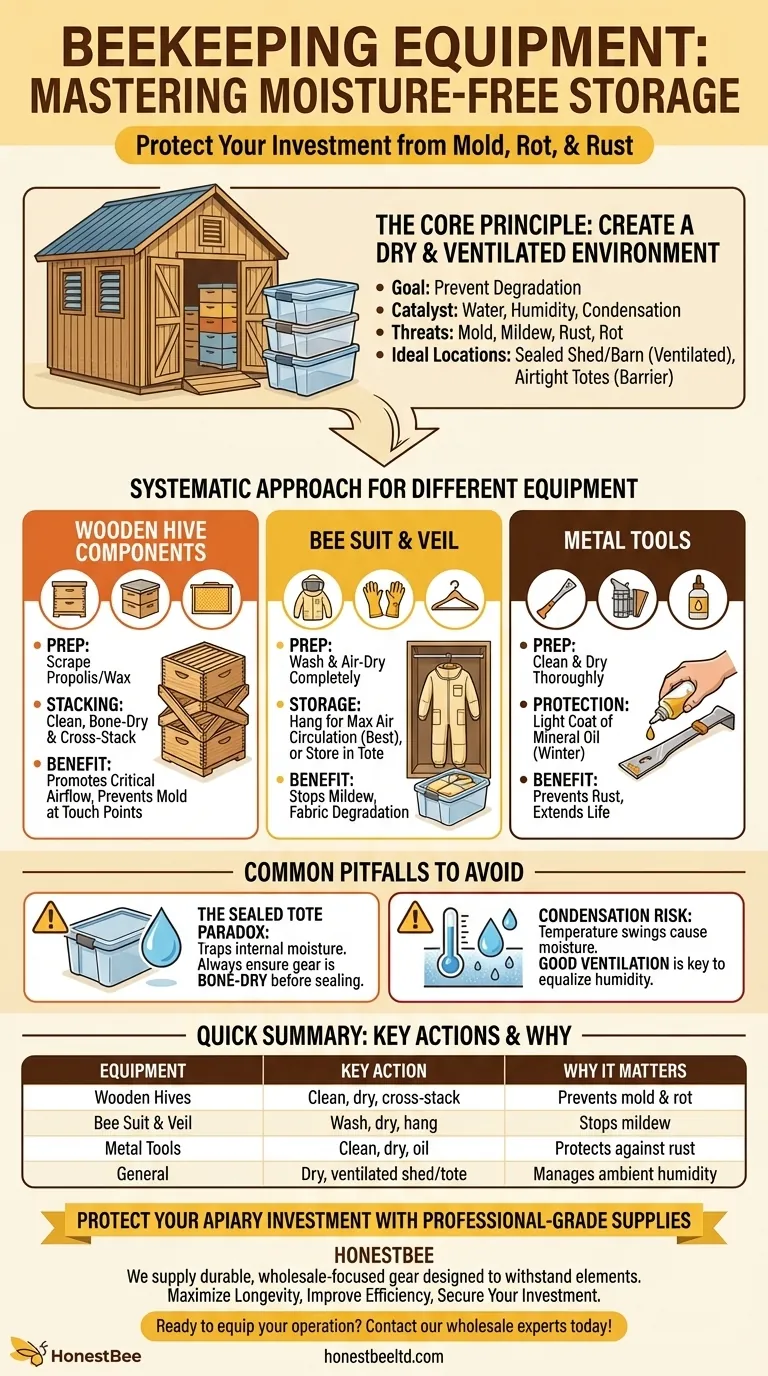At its core, protecting your beekeeping equipment from moisture is about creating a stable, dry, and well-ventilated storage environment. To accomplish this, you must store all gear—including wooden hive bodies, tools, and protective clothing—in a dedicated dry location such as a shed, barn, or sealed tote. This practice is the most effective way to prevent the growth of mold, mildew, and rust, especially during the long, damp off-season.
The central challenge isn't just finding a dry spot; it's managing the entire storage process to eliminate moisture at every step. Storing equipment that is already clean and bone-dry is just as important as the location itself.

The Core Principle: A Dry and Ventilated Environment
Your primary goal is to prevent moisture from degrading your equipment. Water, whether from rain, humidity, or condensation, is the catalyst for rot, mold, and rust, which can ruin your investment.
Why Moisture is the Enemy
Moisture creates the ideal conditions for destructive forces. Wooden hive components will grow mold and begin to rot, weakening their structure and making them unsafe for bees.
Your protective suit and veil, if stored damp, will develop mildew, which can degrade the fabric and pose a health risk. Metal tools, like your hive tool and smoker, will inevitably rust, making them difficult to use and shortening their lifespan.
Ideal Storage Locations
The best location is one you can keep consistently dry. A well-sealed shed or barn is ideal, as it protects from rain and allows for ventilation.
For smaller items like tools, gloves, and veils, a large, airtight plastic tote is an excellent choice. It provides a physical barrier against ambient humidity and pests.
A Systematic Approach for Different Equipment
Different pieces of your beekeeping kit have unique storage needs. A one-size-fits-all approach is less effective than a systematic, item-by-item strategy.
Storing Wooden Hive Components
Before storage, thoroughly scrape all propolis and wax from your supers, hive bodies, and frames. This removes organic matter that can attract pests and hold moisture.
Stack the clean, dry boxes in a "cross-stack" or offset pattern. This promotes critical airflow between each component, preventing condensation and mold from forming where surfaces touch.
Protecting Your Bee Suit and Veil
Your suit and gloves must be completely clean and dry before being put away for any length of time. Wash them according to the manufacturer's instructions and allow them to air-dry thoroughly.
Storing them in a tote is acceptable, but hanging them in a closet or shed is even better. Hanging ensures maximum air circulation around the fabric, offering the best defense against mildew.
Maintaining Your Metal Tools
Clean your hive tool and smoker of all wax and debris. A quick scrub with a steel brush is often sufficient.
Ensure the tools are completely dry before storing them. For long-term winter storage, applying a very thin coat of mineral oil to your hive tool can provide an extra layer of protection against rust.
Understanding the Common Pitfalls
Simply placing gear in a shed is not a guarantee of protection. Awareness of common mistakes is key to preserving your equipment.
The Sealed Tote Paradox
A sealed tote is great at keeping moisture out, but it is equally effective at trapping any moisture that is already in.
Placing even slightly damp frames or a still-humid suit inside a sealed tote creates a perfect micro-climate for mold. Always verify that equipment is bone-dry before sealing it in a container.
The Risk of Condensation
In an unheated shed or barn, temperature swings between day and night can cause condensation to form on cold surfaces, re-introducing moisture to your "dry" storage area.
Good ventilation is the only solution. It allows moist air to escape, equalizing the temperature and humidity with the outside environment and keeping your equipment dry. Never store woodenware directly on a concrete floor, as concrete wicks moisture from the ground.
Making the Right Choice for Your Equipment
Your storage strategy should align with your goals, whether for long-term preservation or short-term organization.
- If your primary focus is long-term winter storage: Prioritize a meticulous process of cleaning, drying, and stacking woodenware to ensure maximum ventilation.
- If your primary focus is organization during the active season: Use clearly labeled totes for smaller items like tools and veils, but ensure they are stored in a dry, shaded location.
- If your primary focus is dealing with high humidity: Invest in high-quality, gasket-sealed totes and consider placing a renewable desiccant pack inside with your most sensitive gear.
Ultimately, viewing equipment storage as an active process of moisture management, not just a passive act of putting things away, will protect your investment for years to come.
Summary Table:
| Equipment Type | Key Storage Action | Why It Matters |
|---|---|---|
| Wooden Hive Components | Clean, dry, and cross-stack for airflow. | Prevents mold, rot, and structural damage. |
| Bee Suit & Veil | Wash, air-dry completely, and hang if possible. | Stops mildew growth and fabric degradation. |
| Metal Tools | Clean, dry thoroughly, and apply a light oil coat. | Protects against rust and extends tool life. |
| General Principle | Store in a dry, well-ventilated shed or sealed tote. | Manages ambient humidity and prevents condensation. |
Protect Your Apiary Investment with Professional-Grade Supplies
Moisture damage can quickly ruin expensive beekeeping equipment. At HONESTBEE, we supply commercial apiaries and equipment distributors with durable, wholesale-focused gear designed to withstand the elements.
We help you:
- Maximize Longevity: Our equipment is built for durability, reducing replacement costs.
- Improve Efficiency: Properly maintained gear means less downtime during the active season.
- Secure Your Investment: Protect your woodenware, suits, and tools from costly moisture damage.
Ready to equip your operation with supplies that last? Contact our wholesale experts today to discuss your needs and discover how HONESTBEE can support your business.
Visual Guide

Related Products
- Premium Traditional Copper Bee Smoker with Bellows
- European Stainless Steel Bee Smoker for Honey Bee Hive
- Stainless Steel Honey Bee Smoker Hive and Honeycomb Smoker for Beekeeping
- Stainless Steel Bee Hive Smoker Beekeeping Smoker for Wholesale
- Stainless Steel Electric Beehive Smoker for Beekeeping and Bee Keeper Use
People Also Ask
- What is a Smoker and how is it used in beekeeping? The Essential Tool for Calm, Safe Hive Inspections
- What are the benefits of using smoke properly in beekeeping? Achieve Calm, Safe Hive Inspections
- What are the main components of a bee smoker? A Guide to Safe and Effective Hive Management
- What are some alternatives to using smoke in beekeeping? A Guide to Gentle Hive Management
- What are the main parts of a bee smoker? Essential Components for Calm Hive Management



















